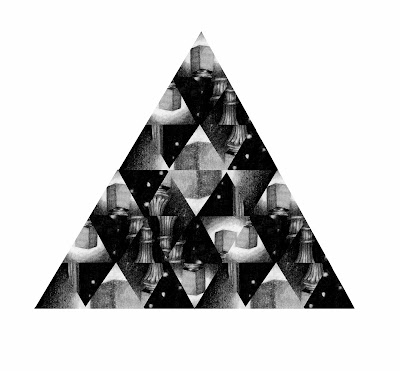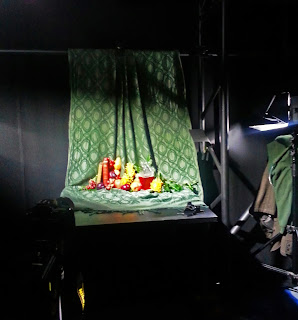After my tutorial with Chris he said that I could interview him for my research report as he has been with his been with his agent Arena for over 14 years and so his answers can tell me a lot about the relationship he has built up with his agent and why he feels they are such a useful tool for him that they have had a significant part in his career. A selection of the interview is here:
C.R.: How long have you been with Arena
Illustration agency for?
C.G.: 14
years
C.R.: How do you go about becoming part of Arena
Illustration? Did you already know someone at the agency, did you approach them
to be represented or did they come to you?
C.G.: I took
a job as Office Assistant/Manager there, with the real intention of getting
onto their books through the back door. It worked! I had gone to see them with
my portfolio in the 2nd year of my degree, and one of the agents there at the
time was a previous student at Norwich, so we knew the same tutors (one of
which, Susan Aldworth) acted as the broker really.
C.R.: What sort of relationship do you have with
your agent? Is it purely professional or more personal/ friendly? Is it a good
relationship?
C.G.: I was lucky enough to work
with Tamlyn when she was a new(ish) agent there, and now she is Director. We
have quite a close relationship, both personally and business wise - she has
helped to grow my career, and I have seen her develop into a strong business
woman. The same goes for Caroline and recently I was invited to her wedding, so
the relationships go beyond purely business. This relationship has also allowed
some of my students to gain work experience within an agency - so they also
trust my judgement. I also remain close with the former Director Alison
Eldred and she still gets me occasional work. They are both lovely, genuine
people with strong morals and belief in Illustration.
C.R.: Have you been with any agents before this
one? If so who? If not then how did you find yourself work? Was it easier or
harder than having an agent?
C.G.: Arena
have been my only agents - I did get some work before them, but not much and I
can't imagine being with another agent - I have heard some bad stories over the
years! I can understand why
some artists are against agents, but I'd rather have 70% of something, rather
than 100% of nothing.
C.R.: How does your agency promote your work?
C.G.: Via
Illustration annuals, advertising, their website/blog and client liaison.
C.R.: Are you allowed to take on other jobs that
are not through your agent? If not has that ever been a problem?
C.G.: Technically
you could, but how could you prove where these people found out about you? I
personally don't. It may well be from your agents advertising, and as such they
are then entitled to a cut. If you have sought out work yourself, then maybe
you should take all the credit and money - but the relationship is important
and should be one of mutual growth. If you want to seek out your own work, and
get it - perhaps you should rethink the need/value of your agent. Hence, no
problem for me but I know of illustrators who have lost agents, or damaged
their relationships because of this attitude.
C.R.: Why do you have an agent? What do they do
for you?
C.G.: I
don't have time to get out there with my work, sometimes not even the
inclination. They also advise on jobs and the process and help with new
promotional work. They can stand up for your rights, and divert conflict and
confrontation if jobs become problematic. Most importantly, they can advise on
legal issues and contracts. It can be lonely as an illustrator, and they act as
your office companions - albeit on the other end of a phone. They also do fab
summer and Xmas parties with free beer and food.
C.R.: Do you ever feel a sense of competition with
other illustrators that your agent represents over who are getting more work?
C.R.: Do you think it’s a useful tool or important
to have an agent in the publishing sector? Does you agent have a lot of
experience with publishing clients?
C.G.: I
think it is almost essential in publishing - contracts are more tricky now, and
the pressures are immense. it is rare that art directors even have the time to
see portfolios, so generally they return to tried and trusted agents to help
them solve their problems.
C.R.: How would charges and commissions work on
book illustration? If it’s a cover is it a one off fee or do you get royalties
with sales? Does the same apply to inside illustrations?
C.G.: Generally,
it is a one off fee for covers....which may result in further payments for
rights, territories and hard/paperback. Contracts are changing however, and now
they want all rights, for a smaller amount - essentially a work for hire
contract where the illustrator has no rights or ownership to the image. This is
a bad turn for the industry and the SAA and AOI are in talks to resolve this
crisis. Children’s' picture books remain one of the only areas of publishing
where the artists gets royalties, and their initial payment is usually and
advance against royalties.
C.R.: Would you ever consider not having an agent?
Why?
C.G.: Not
really, I think they are essential in 2013 and beyond.
I find that having primary research such as interviews really helps me to get involved with my subject as to look at it from a more personal perspective and experience that just reading secondary resources. I plan to interview more agents and illustrators to gather more research and I have got lots of books out from the NUA library to look through that have unbiased opinions on what agents do and how they can be useful.


















































